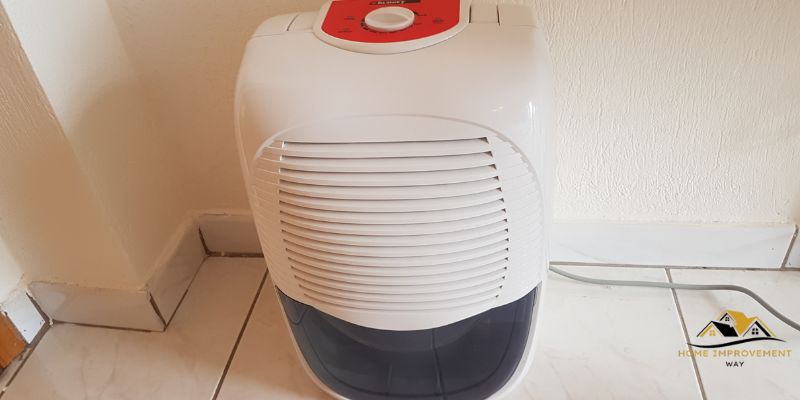To dehumidify a room, use a dehumidifier machine or increase ventilation by opening windows and using fans. Excessively humid rooms can be uncomfortable, promote mold growth, and have a musty odor.
Dehumidifying a room is important for maintaining a healthy and comfortable indoor environment. Whether it’s a small enclosed space or a larger area, controlling the moisture levels is essential. By following a few simple steps, you can effectively reduce the humidity in a room and improve air quality.
We will discuss various methods and tips on how to dehumidify a room, helping you create a more pleasant living or working space.
Understanding Humidity
Understanding humidity is crucial for effectively dehumidifying a room. Learn how to achieve optimal humidity levels and create a comfortable environment with these simple tips.
What Is Humidity?
Humidity is the amount of moisture or water vapor present in the air. It is an important factor that can greatly influence the comfort and health of a room’s occupants. Understanding humidity is crucial for effectively dehumidifying a room and creating an optimal living environment.
Effects Of High Humidity
High humidity levels can have a detrimental impact on our well-being and the condition of our living spaces. Let’s take a closer look at some of the effects of high humidity:
- Discomfort: Excessive moisture in the air can make us feel sticky and uncomfortable, even when the temperature is not particularly high.
- Mold and mildew growth: High humidity provides the perfect breeding ground for mold and mildew, which can cause allergies, respiratory issues, and damage to furniture and belongings.
- Musty odors: A damp environment with high humidity often leads to unpleasant and persistent musty odors that can be hard to eliminate.
- Condensation: When warm, moist air comes into contact with cooler surfaces, such as windows or walls, condensation occurs. This can result in water damage and the formation of mold.
- Decreased air quality: High humidity can create a stuffy and stale atmosphere, contributing to poor indoor air quality and making it harder to breathe.
Now that we understand the negative effects of high humidity, let’s move on to finding solutions and ensuring a healthier, more comfortable living space.

Signs Of Excess Moisture
Excess moisture in a room can lead to a range of problems, from mold and mildew growth to musty odors. By keeping an eye out for these signs, you can take proactive steps to dehumidify your space and create a healthier environment. Let’s explore each of these indicators more closely:
Mold And Mildew Growth
Mold and mildew thrive in damp conditions, making them common culprits when it comes to excess moisture in a room. These fungi can often be found in areas with poor ventilation, such as bathrooms, basements, and kitchens. If you notice black or green spots on walls, ceilings, or surfaces, it’s a clear sign that you have a humidity problem.
Condensation On Windows
One of the easiest signs to spot is condensation on windows. When warm, moist air comes into contact with colder surfaces, such as glass, water vapor condenses into droplets. If you frequently notice foggy or wet windows, it’s a strong indication that the humidity level in your room is too high.
Musty Odors
A distinct musty smell is another telltale sign of excess moisture. The odor is often caused by mold and mildew growth in hidden areas, such as under carpets or inside walls. If you’ve noticed a persistent damp, earthy smell in your room, it’s time to take action to reduce the humidity.
Choosing The Right Dehumidifier
Learn how to choose the perfect dehumidifier for your room and effectively eliminate excess moisture for a healthier environment. Find the best dehumidifying solutions with ease.
When it comes to dehumidifying a room, selecting the right dehumidifier is crucial for effective results. By understanding the factors that determine the ideal dehumidifier for your space, you can ensure a comfortable and healthy environment with optimal humidity levels. Here, we will explore three essential aspects to consider when choosing the right dehumidifier: calculating the required capacity, types of dehumidifiers, and features to consider.
Calculating The Required Capacity
Calculating the required capacity of a dehumidifier is essential to guarantee sufficient moisture removal. To determine the suitable capacity for your room, follow these steps:
- Measure the length, width, and height of the room.
- Multiply these measurements together to find the room’s volume.
- Identify the ideal relative humidity percentage for your desired comfort level. For general comfort, aim for around 45-50%.
- Consult a dehumidifier capacity chart to determine the recommended pint capacity based on the room volume and desired relative humidity.
By accurately calculating the required capacity, you can avoid purchasing a dehumidifier that is either too small to handle the moisture load or unnecessarily oversized.
Types Of Dehumidifiers
Understanding the various types of dehumidifiers available in the market will help you make an informed choice. Here are three common types:
| Type | Description |
|---|---|
| Refrigerant/Compressor | These dehumidifiers use a refrigeration cycle, similar to an air conditioner, to cool air and extract moisture. They are effective in moderate to high humidity conditions. |
| Desiccant | Desiccant dehumidifiers use moisture-absorbing materials like silica gel to remove excess humidity. They are suitable for cold climates and low-temperature areas. |
| Whole House | Designed to dehumidify an entire residence, whole-house dehumidifiers are typically integrated into the HVAC system. They provide continuous moisture control throughout the house. |
By knowing the different types available, you can choose the one that aligns with your specific needs and environmental conditions.
Features To Consider
Choosing a dehumidifier with the right features ensures optimal performance and convenience. Consider the following features when making your decision:
- Humidistat: Look for a dehumidifier with a built-in humidistat that allows you to set and maintain your desired humidity level.
- Automatic Defrost: For areas with low temperatures, an automatic defrost feature prevents ice buildup on the coils, ensuring consistent operation.
- Noise Level: If noise is a concern, opt for a dehumidifier with a lower decibel rating for quiet operation.
- Portability: If you plan to move the dehumidifier between different rooms, consider a lightweight and portable model with casters for easy mobility.
By considering these features, you can select a dehumidifier that perfectly suits your needs, providing efficient moisture control without sacrificing convenience.
Preparing The Room For Dehumidification
Before you start dehumidifying a room, it’s important to prepare the space properly. By taking a few simple steps, you can ensure that the dehumidifier works efficiently and effectively. In this section, we will discuss three key aspects of preparing the room for dehumidification: identifying problem areas, improving ventilation, and removing moisture sources. Let’s dive in!
Identifying Problem Areas
If you’re dealing with excessive humidity in a room, it’s essential to identify the problem areas first. Start by observing the space and looking for signs of moisture or condensation. Check for water stains on walls or ceilings, damp spots on carpets, or musty odors, as these are indicators of high humidity levels. Additionally, pay attention to windows and doors, as these areas are prone to moisture seepage.
Improving Ventilation
To effectively dehumidify a room, it’s crucial to improve ventilation. Good airflow helps to circulate the air and reduce humidity levels. Here are a few simple ways to enhance ventilation in your space:
- Open windows and doors: Whenever possible, open windows and doors to allow fresh air to enter and stale air to exit. This simple step can significantly improve air circulation and reduce humidity.
- Use fans: Place fans strategically in the room to facilitate air movement. You can utilize ceiling fans or portable fans to keep the air flowing, especially in problem areas.
- Clean air vents: Ensure that air vents are clean and unobstructed. Clogged vents can hinder proper airflow, contributing to increased humidity levels. Regularly clean them to maintain optimal ventilation.
Removing Moisture Sources
To effectively dehumidify a room, it’s essential to identify and eliminate moisture sources. By eliminating these sources, you can prevent excess moisture from accumulating. Here are a few steps you can take:
- Fix water leaks: Inspect the room for any water leaks, such as dripping pipes, faucets, or roof leaks. Fixing these issues will prevent further moisture from entering the space, helping to reduce humidity.
- Use moisture absorbers: Place moisture absorbers, such as silica gel packs or activated charcoal, in problem areas. These absorbent materials can help to reduce excess moisture in the air.
- Avoid drying clothes indoors: If possible, avoid drying clothes indoors as the evaporating moisture increases humidity. Opt for outdoor drying or use a dryer to minimize moisture release in the room.
- Cover boiling pots: When cooking, cover pots and pans with lids to minimize steam escaping into the room. This simple practice can help to prevent additional moisture from being introduced into the air.
By following these steps, you can effectively prepare the room for dehumidification. Identifying problem areas, improving ventilation, and removing moisture sources will create an optimal environment for the dehumidifier to function efficiently and maintain balanced humidity levels in the room.

Using A Dehumidifier Effectively
Dealing with excess humidity in a room can be a real challenge. Thankfully, a dehumidifier can come to the rescue. However, simply purchasing a dehumidifier is not enough to solve the problem. To ensure optimal results, it is essential to use a dehumidifier effectively. In this article, we will discuss three key aspects of using a dehumidifier effectively: placement and positioning, setting the ideal humidity level, and maintenance and cleaning.
Placement And Positioning
Where you place your dehumidifier can greatly influence its effectiveness. To maximize the efficiency of your dehumidifier, consider the following tips:
- Position the dehumidifier in the area of the room where humidity is most prevalent, such as near a window, in a damp corner, or where moisture tends to accumulate.
- Avoid obstructing the dehumidifier’s air intake and outlet vents. Leave sufficient space around the unit to allow proper airflow.
- If possible, elevate the dehumidifier by placing it on a table or countertop. This helps it draw moisture from a larger area and circulate air more effectively.
Setting The Ideal Humidity Level
Knowing the appropriate humidity level for your room is crucial for effective dehumidification. To determine and maintain the ideal humidity level, follow these steps:
- Start by measuring the current humidity level using a hygrometer. Ideally, indoor humidity should range between 30% and 50%.
- If the humidity level is too high, set the dehumidifier’s controls to a lower percentage to remove excess moisture from the air.
- Regularly monitor the humidity level and adjust the settings accordingly. Striking the right balance is essential for optimal comfort and preventing mold and mildew growth.
Maintenance And Cleaning
Proper maintenance and regular cleaning are essential for keeping your dehumidifier operating efficiently. Follow these guidelines:
| Maintenance Tasks | Frequency |
| Change or clean the dehumidifier’s filter. | Every 3-6 months (check the manufacturer’s recommendations). |
| Empty the water collection bucket. | When the bucket is full or as needed. |
| Inspect the coils for dust and debris. | Once a month or as needed. |
| Clean the exterior of the dehumidifier. | As needed. |
By following these maintenance tasks, you can ensure that your dehumidifier runs smoothly and continues to effectively reduce the humidity in your room.
Conclusion
Dehumidifying a room is a key step in maintaining a comfortable living environment. By following the tips mentioned in this post, such as using a dehumidifier, improving ventilation, and reducing sources of moisture, you can effectively control humidity levels in your home.
Remember, a balanced humidity level not only prevents mold and mildew growth but also promotes better health and well-being for you and your family. So take action today and create a dry and healthy space for everyone to enjoy.


